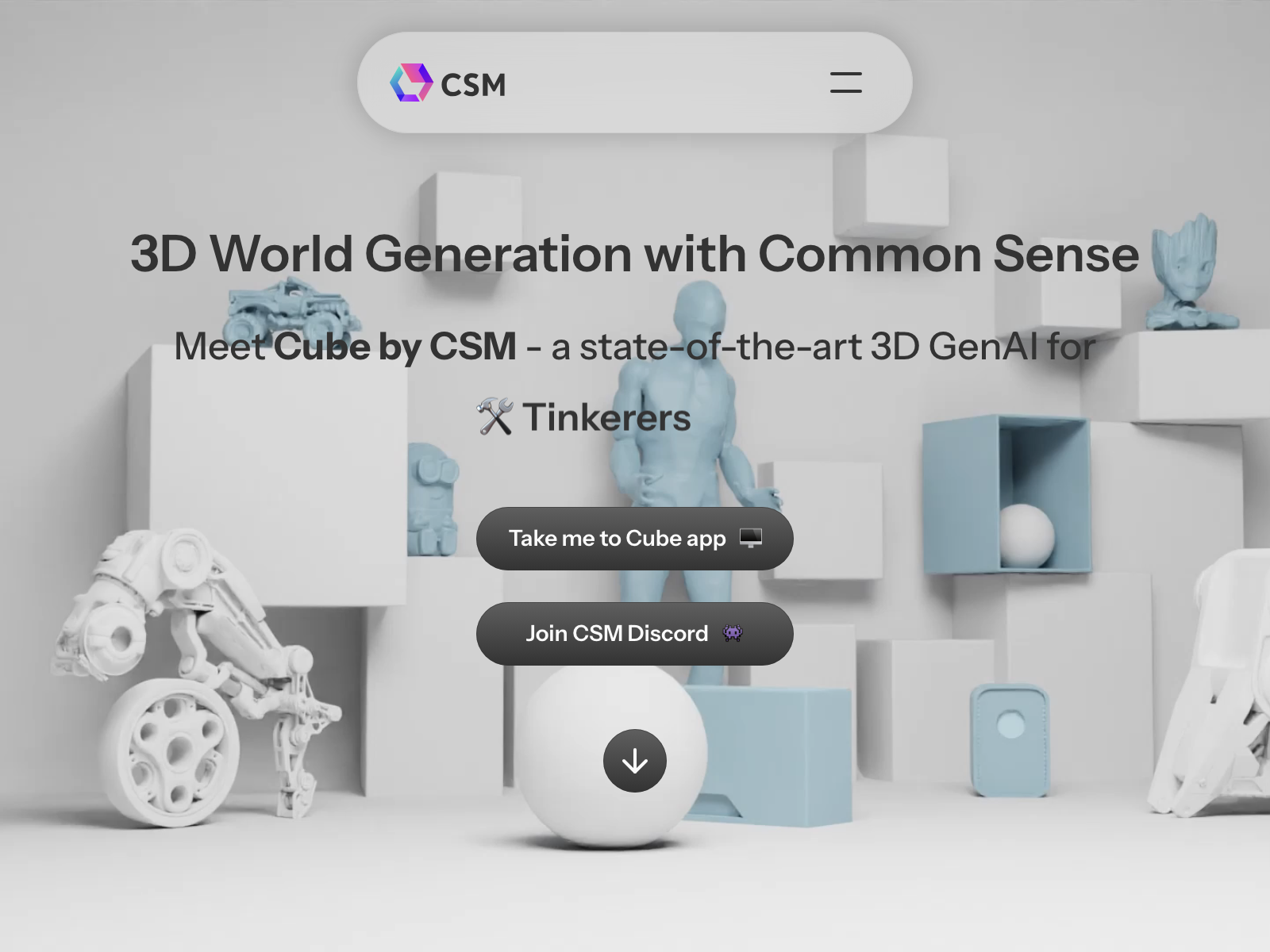CSM: Turn Photos into 3D Animated Worlds

Common Sense Machines Overview
Common Sense Machines (CSM) is building an AI product that lets users generate controllable and game-engine ready 3D animated worlds from single images. This innovative tool aims to revolutionize the way we create and interact with virtual environments, making 3D content creation more accessible and efficient.
In our in-depth review, we'll explore the key features, use cases, pros and cons, pricing, and available alternatives of this cutting-edge AI tool. Whether you're a game developer, 3D artist, or simply someone interested in the power of AI-driven content creation, this review will provide you with a comprehensive understanding of CSM and its capabilities.
Common Sense Machines Key Features
-
Image-to-3D Conversion: CSM's core functionality allows users to upload a single image and have it automatically converted into a fully-fledged 3D animated world. This feature streamlines the 3D content creation process, saving valuable time and resources.
-
Controllable Environments: The generated 3D worlds are not static; they are fully interactive and can be manipulated by the user. This enables users to explore, modify, and animate the environments according to their creative vision.
-
Game-Engine Integration: The 3D worlds created by CSM are optimized for direct integration into popular game engines, such as Unity and Unreal Engine. This seamless integration facilitates the development of immersive gaming experiences and interactive applications.
-
Realistic Textures and Lighting: CSM's advanced algorithms ensure that the generated 3D environments exhibit realistic textures, materials, and lighting, providing a visually stunning and immersive experience.
-
Intuitive User Interface: The CSM platform features a user-friendly interface that allows even non-technical users to navigate the 3D content creation process with ease. The intuitive tools and customization options empower users to bring their ideas to life.
Common Sense Machines Use Cases
The versatility of CSM makes it applicable in a wide range of industries and use cases, including:
-
Game Development: Game developers can use CSM to quickly generate unique and visually appealing 3D environments, accelerating the content creation process and reducing development time.
-
Architectural Visualization: Architects and interior designers can leverage CSM to create detailed 3D models of their designs, enabling more effective client presentations and project planning.
-
Education and Training: Educators and training providers can utilize CSM to create immersive, interactive learning environments that enhance the educational experience for students and trainees.
-
Virtual Events and Metaverse: Event organizers and metaverse developers can employ CSM to construct visually striking and customizable 3D virtual spaces for conferences, exhibitions, and other digital experiences.
Common Sense Machines Pros and Cons
Pros:
- Streamlined 3D content creation process from single images
- Highly customizable and controllable 3D environments
- Seamless integration with popular game engines
- Realistic textures, materials, and lighting
- Intuitive user interface for non-technical users
Cons:
- Initial setup and learning curve may be challenging for some users
- Limited support for advanced 3D modeling features compared to dedicated software
- Potential limitations in the complexity and detail of the generated 3D worlds
Common Sense Machines Pricing
Common Sense Machines offers the following pricing tiers:
| Plan | Price | Features |
|---|---|---|
| Basic | $19/month | - 5 image-to-3D conversions per month |
| Pro | $49/month | - Unlimited image-to-3D conversions |
| Enterprise | Custom | - Dedicated support |
Common Sense Machines Alternatives
While Common Sense Machines is a unique and innovative AI-powered 3D content creation tool, there are a few alternative options worth considering:
- Daz 3D: A comprehensive 3D modeling and animation suite with a focus on realistic human and character creation.
- Blender: A free and open-source 3D creation suite with a wide range of features for modeling, animation, and rendering.
- Unity: A popular game engine that offers extensive tools and resources for 3D content creation and game development.
These alternatives provide different levels of complexity, functionality, and target use cases, catering to a diverse range of user needs and skill levels.
Common Sense Machines FAQ
1. How accurate are the 3D environments generated by CSM? The 3D environments generated by CSM are highly accurate and realistic, thanks to the advanced AI algorithms and deep learning models powering the platform. While they may not match the level of detail and fidelity of manually created 3D models, the generated environments exhibit convincing textures, materials, and lighting that can serve the needs of many use cases.
2. Can I customize the generated 3D environments? Yes, CSM offers a range of customization options that allow users to modify the generated 3D environments. This includes adjusting camera angles, adding or removing objects, changing materials and textures, and even animating certain elements. The level of customization varies based on the pricing plan, with the Pro and Enterprise plans offering the most advanced editing capabilities.
3. How well does CSM integrate with popular game engines? CSM is designed to seamlessly integrate with leading game engines, such as Unity and Unreal Engine. The generated 3D environments can be directly imported into these engines, allowing game developers to quickly incorporate the content into their projects. The integration process is streamlined, reducing the time and effort required to build immersive gaming experiences.
4. Is there a free trial or demo available for CSM? Yes, Common Sense Machines offers a free trial period, allowing users to test the platform and its features before committing to a paid subscription. The free trial provides access to a limited set of functionalities, typically with a cap on the number of image-to-3D conversions or the scope of customization options. This allows prospective users to evaluate the tool's capabilities and determine if it aligns with their specific needs.
Visit the Common Sense Machines website (opens in a new tab) to learn more about the tool and explore the available pricing plans.